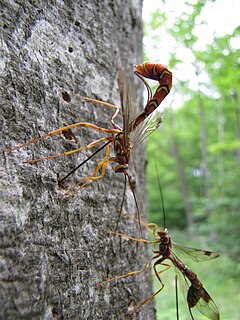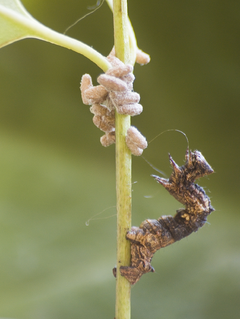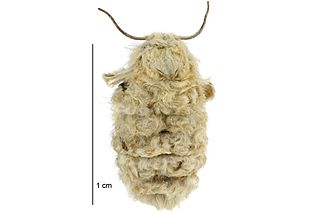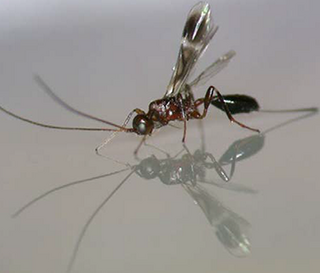This article may be too technical for most readers to understand. Please help improve it to make it understandable to non-experts, without removing the technical details. (September 2014) (Learn how and when to remove this template message) |
| Cotesia urabae | |
|---|---|
| Scientific classification | |
| Kingdom: | Animalia |
| Phylum: | Arthropoda |
| Class: | Insecta |
| Order: | Hymenoptera |
| Family: | Braconidae |
| Genus: | Cotesia |
| Species: | C. urabae |
| Binomial name | |
| Cotesia urabae Austin & Allen | |
Cotesia urabae is a small (2.5-3.2 mm long) wasp, having a black body with yellow-brown legs, characterized by a solitary larval endoparasitoid stage (Austin and Allen, 1989). It is part of a large complex of 11 primary parasitoids of Uraba lugens Walker, many of which are polyphagous (Allen, 1990a, 1990b). The female inserts its ovipositor into the a U. lugens larva, depositing its eggs there, and it has been found that one female may carry up to 400 eggs (Allen, 1989). While C. urabae females are able to attack the same larva several times; only one single parasitoid completes its development in each larva (Berndt, 2010).

A parasitoid is an organism that lives in close association with its host and at the host's expense, and which sooner or later kills it. Parasitoidism is one of six major evolutionary strategies within parasitism, distinguished by the fatal prognosis for the host, which makes the strategy close to predation.

Uraba lugens, the gum-leaf skeletoniser, is a moth of the family Nolidae. It is found in Australia and New Zealand. The larvae are a serious pest of Eucalyptus species and their close relatives. The wingspan is 25–30 mm. In Australia there are about one or two generations per year.
Once the C. urabae larvae emerges from the host larvae, a tightly woven sulphur-yellow pupal cocoon in a loose surrounding silk matrix is spun by C. urabae to pupate alongside the host (Allen, 1990a). There is considerable variation in the time that the larval stage spends developing inside the host, and it ranges between 14 days in summer and 20 days in winter. The adults’ emergence takes place after 8 days pupation, when a cap is cut and pushed off at the end of the cocoons allowing the adult to emerge and disperse. The adult lives for approximately 27 days (Allen, 1990b). It has been described that C. urabae has 2 generations within each generation of its host U. lugens, and no overlapping of adults of each C. urabae generation has been observed in the field (Allen, 1990a).
Cotesia urabae was introduced in New Zealand in 2011 as a biological control agent against the eucalyptus pest Uraba lugens, commonly known as the gum leaf skeletoniser (Avila et al. 2013). The biological control of the gum leaf skeletonizer is a novel biocontrol program, being the first attempt at control of this invasive moth in New Zealand. It has been predicted that C. urabae will lead to a considerable decrease on the existing population of U. lugens, along with providing several social and economic benefits (Avila et al. 2013).












